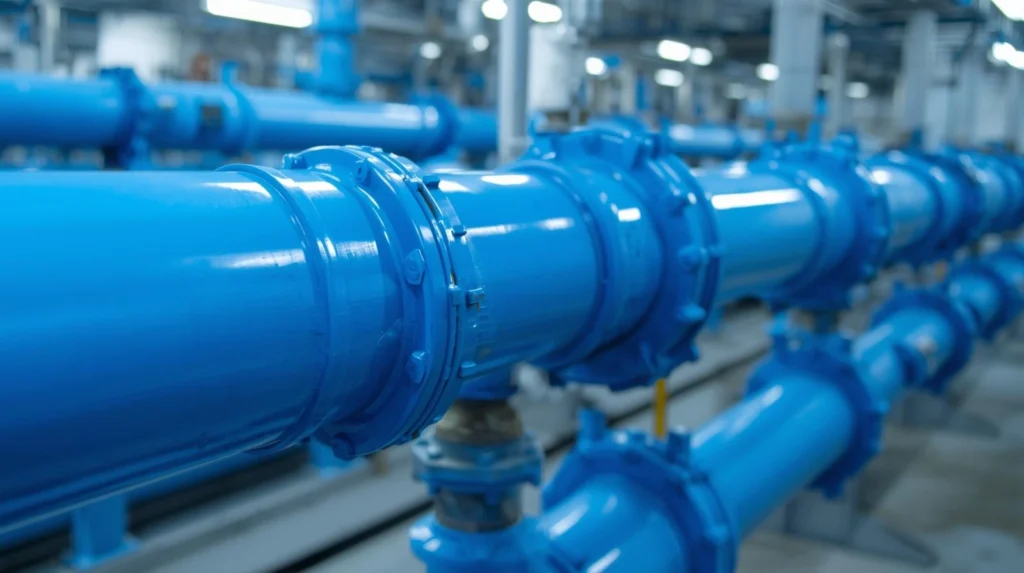How can we ensure safe, clean drinking water reaches every home without contamination or leakage?
This is a question that communities around the world are striving to answer, especially in regions where outdated infrastructure and poor water distribution systems plague daily life. A reliable and efficient solution to this ongoing problem lies in the use of High-Density Polyethylene (HDPE) pipes in potable water systems.
With water scarcity and quality concerns on the rise, particularly in developing countries like Pakistan, it’s more important than ever to explore the potential of HDPE pipes in safeguarding public health. In this blog, you’ll discover how HDPE pipes are revolutionizing potable water systems, enhancing the safety and sustainability of water distribution networks.
Why Are HDPE Pipes the Ideal Choice for Safe Drinking Water?
What makes HDPE pipes stand out from other piping options when it comes to safe drinking water?
HDPE pipes are crafted from a robust, flexible, and corrosion-resistant material that makes them perfect for carrying drinking water. Unlike traditional materials such as concrete or steel, HDPE offers a variety of benefits in both installation and long-term performance.
Key benefits of HDPE pipes for potable water include:
- Corrosion Resistance: HDPE pipes are impervious to rust, which is a common issue with metal pipes. This ensures that the water supply remains uncontaminated by harmful metals.
- Leak Prevention: The seamless nature of HDPE pipes reduces the risk of leaks, preventing water wastage and contamination.
- Durability: These pipes are designed to withstand extreme temperatures and pressures, making them suitable for all weather conditions.
A recent study by the World Health Organization found that over 1 billion people are affected by poor-quality drinking water due to contaminated pipes and infrastructure failures. By switching to HDPE pipes, municipalities can significantly reduce this risk and improve water quality.
How HDPE Pipes Improve the Efficiency of Potable Water Systems
Can HDPE pipes really reduce water loss and increase efficiency in distribution systems?
Absolutely. Water loss is a major challenge in many parts of the world, with aging pipes contributing to over 30% of total water wastage in some countries. HDPE pipes play a crucial role in improving the efficiency of drinking water systems, reducing both leaks and the need for frequent maintenance.
Key factors contributing to efficiency:
- Seamless Design: HDPE pipes are made without joints or seams, which reduces the possibility of leakages. This helps maintain water pressure and prevents contamination from external elements.
- Long-Lasting Performance: With a lifespan of up to 50 years, HDPE pipes minimize the need for frequent replacements, reducing operational costs and ensuring a consistent water supply.
For example, in the city of Karachi, Pakistan, the introduction of HDPE pipes for the water supply system led to a 20% decrease in water loss within the first year of implementation. This has helped conserve both water resources and energy used in treating and pumping water.
Environmental Impact: How HDPE Pipes Contribute to Sustainable Water Infrastructure
What role do HDPE pipes play in building more sustainable water systems?
Sustainability is one of the most pressing concerns in modern infrastructure development. HDPE pipes not only address environmental issues but also promote a circular economy by being fully recyclable. Their use contributes significantly to reducing environmental degradation caused by traditional pipe materials.
Environmental benefits of HDPE pipes:
- Recyclable and Sustainable: HDPE pipes can be recycled at the end of their life cycle, reducing plastic waste and promoting sustainability.
- Low Carbon Footprint: The manufacturing process for HDPE pipes emits fewer greenhouse gases compared to other materials, making them a more eco-friendly option.
Cities like Lahore have begun integrating HDPE pipes into their urban water infrastructure to lower carbon footprints while simultaneously improving water delivery systems.
Real-World Case Studies: Success Stories of HDPE Pipe Implementation
How have other regions benefited from HDPE pipes in their water distribution systems?
Several cities worldwide have seen tangible improvements in their potable water systems by implementing HDPE pipes. Here are a few examples:
- Cape Town, South Africa: Faced with a severe water crisis, Cape Town switched to HDPE pipes for both water delivery and wastewater systems. The result? A 15% increase in water savings, significantly reducing the risk of contamination.
- New Delhi, India: In 2022, the city installed HDPE pipes across major water distribution networks. This reduced leakage rates by 25%, ensuring more water reached homes without loss or contamination.
- Karachi, Pakistan: As mentioned earlier, Karachi’s decision to replace old, leaking pipes with HDPE options helped reduce water loss by 20% in just one year.
These case studies underline the critical role of HDPE pipes in ensuring water quality, reducing waste, and enhancing the reliability of drinking water systems.
The Future of HDPE Pipes in Potable Water Systems
Are HDPE pipes the future of safe drinking water distribution?
With the growing demand for sustainable, efficient, and cost-effective water systems, HDPE pipes are undoubtedly leading the way in modern infrastructure. The future of potable water distribution looks bright, as more governments and private sectors begin to recognize the advantages of HDPE.
Recent trends show that by 2030, approximately 75% of all new water pipelines in urban areas will be made from HDPE. This is a significant shift from the past reliance on older materials like concrete and steel, highlighting the growing confidence in HDPE’s performance.
Pro Tips for Selecting HDPE Pipes for Your Water System
What factors should you consider when choosing HDPE pipes for your water system?
- Pipe Diameter and Length: Ensure that the pipe size matches the required water flow and pressure needs.
- Pipe Quality: Look for certified HDPE pipes that comply with international standards, such as those approved by the American Water Works Association (AWWA).
- Installation Method: Work with experienced professionals who are trained in the correct installation of HDPE pipes to avoid potential issues.
Conclusion
In conclusion, HDPE pipes offer a reliable, sustainable, and cost-effective solution to safe drinking water distribution. Their resistance to corrosion, low maintenance costs, and environmental benefits make them the ideal choice for modernizing water infrastructure. Whether you’re planning a new water system or looking to upgrade your existing network, HDPE pipes provide the durability and efficiency needed to ensure safe, clean drinking water for generations to come.
FAQ Section
1. What are HDPE pipes made from?
HDPE pipes are made from high-density polyethylene, a strong, flexible plastic that is resistant to corrosion and chemicals, making it ideal for transporting drinking water.
2. How long do HDPE pipes last?
HDPE pipes typically have a lifespan of up to 50 years, depending on installation conditions and usage.
3. Can HDPE pipes be used for hot water systems?
HDPE pipes are primarily used for cold and potable water systems. For hot water systems, PEX or CPVC pipes are typically preferred due to their higher heat resistance.
4. Are HDPE pipes environmentally friendly?
Yes, HDPE pipes are fully recyclable and have a low carbon footprint compared to traditional piping materials like steel and concrete.
5. How much water can HDPE pipes save?
HDPE pipes can reduce water loss by up to 30%, making them an essential solution for water-scarce regions.
6. Are HDPE pipes easy to install?
Yes, HDPE pipes are relatively easy to install due to their lightweight nature and seamless design, which reduces the risk of leaks.
7. Where are HDPE pipes most commonly used?
HDPE pipes are widely used in water supply systems, wastewater systems, gas distribution, and even in agriculture for irrigation.


